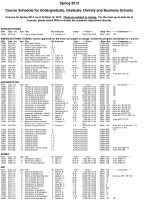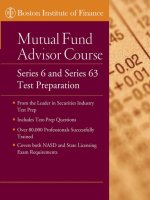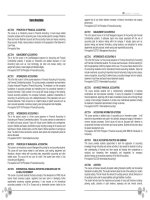INTRADAY TRADING USING THE WYCKOFF METHOD Course slides Ebook
Bạn đang xem bản rút gọn của tài liệu. Xem và tải ngay bản đầy đủ của tài liệu tại đây (5.91 MB, 66 trang )
WYCKOFF ASSOCIATES, LLC
PRESENTS
INTRADAY TRADING
USING THE WYCKOFF
METHOD
INTRADAY TRADING USING THE WYCKOFF METHOD WORKSHOP
March 19, 2016
SWING TRADING USING THE WYCKOFF
METHOD
March 19, 2016
Today’s Schedule:
8:30 – 10:20 am - Part I
10:20 – 10:30 am - Break
10:30 – 12:30 pm - Part II
12:30 – 1:15 pm - Lunch
1:15 – 2:50 pm - Part III
2:50 – 3:00 pm - Break
3:00 – 4:30 pm - Part IV
Video recording: This workshop will be recorded for further distribution to
workshop participants. These recordings are intended for your own use only.
Please respect the proprietary, copyrighted nature of the materials and do not
share or distribute them.
Workshop slides: The PDF slides file will be available to you. Make a lot of notes,
but be ready to engage in the discussion.
Lunch: Lunch break is from 12:30 to 1:15 pm. Please return on time!
Evaluation form: We will ask you to complete an evaluation form after the
workshop. We would greatly appreciate your feedback to help improve the
workshop for future presentations.
Most importantly:
HAVE A GREAT EXPERIENCE LEARNING ABOUT WYCKOFF INTRADAY
TRADING!
www.WyckoffAnalytics.com
Copyright © 2016 Wyckoff Associates, LLC. All Rights Reserved.
Disclaimer
Roman Bogomazov (“Presenter”) is not a registered investment advisor or broker-dealer and does not purport to
recommend or suggest any securities to buy or sell. You understand and acknowledge that there is a very high degree of
risk involved in trading securities. Presenter assumes no responsibility or liability for your trading and investment
results. You and you alone are responsible for your own trading and investment decisions and results.
It should not be assumed that the methods, techniques, or indicators presented will be profitable or that they will not
result in losses. Past results of any individual trader or trading system published by Presenter are not indicative of future
returns by that trader or system, and are not indicative of future returns which will be realized by you. In addition, the
indicators, strategies, articles and all other features of Presenter's products are provided for informational and
educational purposes only and should not be construed as investment advice. Accordingly, you should not rely solely on
the Presenter’s information in making any investment. Rather, you should use the Presenter’s information only as a
starting point for doing additional independent research in order to allow you to form your own opinion regarding
investments. You should always check with your licensed financial advisor and tax advisor to determine the suitability of
any investment.
HYPOTHETICAL OR SIMULATED PERFORMANCE RESULTS HAVE CERTAIN INHERENT LIMITATIONS. UNLIKE AN ACTUAL
PERFORMANCE RECORD, SIMULATED RESULTS DO NOT REPRESENT ACTUAL TRADING AND DO NOT INCLUDE
BROKERAGE AND OTHER FEES, OR SLIPPAGE. ALSO, IN SIMULATED PERFORMANCE RESULTS NO TRADES HAVE ACTUALLY
BEEN EXECUTED, AND THEREFORE THE RESULTS MAY HAVE UNDER- OR OVER-COMPENSATED FOR THE IMPACTS OF A
VARIETY OF MARKET FACTORS, SUCH AS LACK OF LIQUIDITY. SIMULATED TRADING PROGRAMS, IN GENERAL, CAN ALSO
BE DESIGNED WITH THE BENEFIT OF HINDSIGHT. NO REPRESENTATION IS BEING MADE THAT ANY ACCOUNT WILL OR IS
LIKELY TO ACHIEVE PROFITS OR LOSSES SIMILAR TO THOSE SHOWN.
INTRODUCTION
www.WyckoffAnalytics.com
Copyright © 2016 Wyckoff Associates, LLC. All Rights Reserved.
MY TRADING TRAINING AND TEACHING EXPERIENCE
Roman Bogomazov:
-Originally from Vladivostok, Russia. Immigrated in 1996.
Education:
- Student at Golden Gate University (GGU) in 1997-2000. Bruce Fraser and Professor Hank Pruden were my
teachers and continue to be my mentors
- Certificate in technical market analysis and MS in Finance, both from GGU
- Passed Level I and II CMT designation exams
- Series 7 designation
Trading experience:
- I consult for hedge funds and other financial institutions on trading strategies and implementation
- I have been trading for the last 20 years. I have traded stocks, options, futures, and forex
- I trade two strategies: (1) a short-term swing/intraday strategy, based on momentum of a swing;
(2) longer-term swing trading of stocks based on the Wyckoff methodology
Teaching and coaching:
- Teaching FI354 and FI355 Wyckoff classes online at Golden Gate University
- Teaching an Advanced Wyckoff Trading Course (AWTC), Wyckoff Practicum Trading Course (WPTC) and
conducting weekly Market and Stocks Outlook (MASO) sessions with Wyckoff Associates, LLC
Affiliations:
- Past President of TSAASF (www.tsaasf.org) and Board Member of IFTA (ifta.org)
- Member of San Francisco chapter of Ed Seykota’s trading tribe
www.WyckoffAnalytics.com
Copyright © 2016 Wyckoff Associates, LLC. All Rights Reserved.
INTRADAY TRADING USING THE WYCKOFF METHOD
March 19, 2016
Student Intentions:
- Name
- Your intention: what do you hope to gain from this workshop?
Copyright © 2016 Wyckoff Associates, LLC. All Rights Reserved.
WORKSHOP OUTLINE
www.WyckoffAnalytics.com
Copyright © 2016 Wyckoff Associates, LLC. All Rights Reserved.
INTRADAY TRADING USING THE WYCKOFF METHOD
March 19, 2016
Outline of material for today (page 1):
www.WyckoffAnalytics.com
1.
Introduction
2.
The Wyckoff Method Review
•
Change of Character
•
Wyckoff Phase Analysis
•
Wyckoff Accumulation Trading Range Events
•
Wyckoff Distribution Trading Range Events
•
Swing Reversal Concept
3.
Synchronization of Different Time Frame Structures
•
Case Study #1: EURUSD
•
Monthly EURUSD structure
•
Daily EURUSD structure
•
240 minutes EURUSD structure
•
30 minutes EURUSD structure
•
Points of Entry
ã
Different trading sessions
Copyright â 2016 Wyckoff Associates, LLC. All Rights Reserved.
INTRADAY TRADING USING THE WYCKOFF METHOD
Outline of material for today (page 2):
4.
Selection of the Momentum Stocks for Day Trading
•
Case Study #2: AMZN
•
Leadership with momentum stocks
•
Identification of the Daily Swing Bias
•
Identification of the Daily Chart Trend
•
Identification of the Daily Swing Structure
•
Resumption of the Leadership Trend on a lower time frame
5. General Guidelines and Rules for Day Trading Momentum Stocks
6. Intraday Comparative Selection and Points of Entry
• Case Study #3: Momentum Stocks (FANG)
• Daily Swing Bias
• Comparative evaluation of the first 30 minutes of a session
• Intraday points of entry
7. Intraday Trades vs. Intraday Switch to a Swing Trade
• Case Study #4: GOOGL
• Long-term price analysis
• Daily swing reversal
• Predominant intraday trend
• Intraday points of entry
• Comparison between intraday and swing trades
www.WyckoffAnalytics.com
Copyright © 2016 Wyckoff Associates, LLC. All Rights Reserved.
SWING TRADING USING THE WYCKOFF METHOD
Outline of material for today (page 3):
8. Intraday Switch to a Swing Trade - I
• Case Study #5: MNST
• Intraday point of entry switch to a swing trade
• Intraday points of entry
9.
General Guidelines and Rules for Trading E-minis
•
Rules and Guidelines
•
Exercise
10. Trading Intraday Price Structure
• Case Study #6: ES
• Daily Swing Bias analysis
• Daily chart structural analysis
• Exercise: Combining intraday structural analysis with intraday swing
reversal entries
11. Intraday Switch to a Swing Trade - II
• Case Study #7: ES
• Daily structural analysis
• Intraday price structure
• Intraday points of entry
12. Q&A session
www.WyckoffAnalytics.com
Copyright © 2016 Wyckoff Associates, LLC. All Rights Reserved.
The Wyckoff Method Main
Structural Concepts
+
Reversal of a Swing Concept
www.WyckoffAnalytics.com
Copyright © 2016 Wyckoff Associates, LLC. All Rights Reserved.
CHoCH
CHANGE OF CHARACTER (CHoCH)
CHoCH
WHEN does a trend change into consolidation?
HOW can we identify this change in environment?
Phase A
Phase D
“The Creation of a Trend”
CHoCH
Phase A
Non-trending environment
www.WyckoffAnalytics.com
CHoCH
Phase D
Trending environment
Non-trending environment
Trending
Copyright © 2016 Wyckoff Associates, LLC. All Rights Reserved.
STRUCTURAL ANALYSIS: What are Wyckoff Phases?
INTENTIONS BEHIND PHASES (Accumulation)
STOP
BUILD CAUSE
SUPPLY & DEMAND
TEST
MARKUP
in TR
MARKUP
out of TR
CHoCH
CHoCH
Wyckoff Buy Zone
www.WyckoffAnalytics.com
Copyright © 2016 Wyckoff Associates, LLC. All Rights Reserved.
STRUCTURAL ANALYSIS: What are Wyckoff Accumulation Events?
ELEVEN WYCKOFF TRADING
RANGE EVENTS
(Accumulation)
1. PS – preliminary support, where
substantial buying begins to provide
pronounced support after a prolonged
down-move. Volume and
the price spread widen and provide
a signal that the down-move may be
approaching its end.
2. SC – selling climax, the point at
which widening spread and selling
pressure usually climaxes and
heavy or panicky selling by the
public is being absorbed by larger
professional interests at prices near
the bottom. At the low, the climax
helps to define the lower level of the
trading range.
3. AR – automatic rally, where selling
pressure has been exhausted. A wave
of buying can now easily push up
prices, which is further fuelled by
short covering. The high of this rally
will help define the top of the trading
range.
4. ST – secondary test, price revisits
the area of the selling climax to
test the supply/demand at these
price levels. If a bottom is to be
confirmed, significant supply should
not resurface, and volume and
price spread should be significantly
diminished as the market approaches
support in the area of the SC.
5. The “Creek” is a wavy line of
resistance drawn loosely across rally
peaks within the trading range. There
are minor lines of resistance and a
www.WyckoffAnalytics.com
more significant “creek” of supply
that will have to be crossed before
the market’s journey can continue
onward and upward.
6-7. “Springs” or “shakeouts” usually
occur late within the trading range
and allow the dominant players to
make a definitive test of available
supply before a markup campaign
will unfold. If the amount of supply
that surfaces on a break of support is
very light (low volume), it will be an
indication that the way is clear for a
sustained advance. Heavy supply here
usually means a renewed decline.
Moderate volume here may mean
more testing of support and a time
to proceed with caution. The spring
or shakeout also serves the purpose
of providing dominant interests with
additional supply from weak holders
at low prices.
8. “Jump” – continuing the creek
analogy, the point at which price
jumps through the resistance line; a
bullish sign if the jump is achieved
with increasing speed and volume.
9. SOS – sign of strength, an
advance on increasing spread and
volume, usually over some level of
resistance
10-11. BU/LPS – last point of support,
the ending point of a reaction or
pullback at which support was
met. Backing up to an LPS means
a pullback to support that was
formerly resistance, on diminished
spread and volume after an SOS.
This is a good place to initiate long
positions or to add to profitable ones.
Copyright © 2016 Wyckoff Associates, LLC. All Rights Reserved.
STRUCTURAL ANALYSIS: What are Wyckoff Events?
www.WyckoffAnalytics.com
ELEVEN WYCKOFF TRADING
RANGE EVENTS
(Distribution)
7. (MSOW) Major sign of weakness, a
pronounced break through the ice that will
likely be followed by attempts to get back
above it. A failure to get back above firm
1. (PSY) Preliminary Supply, where
support may mean a “drowning” for the
market.
substantial selling begins to provide
8. (LPSY) Last Point of Supply After we test
pronounced resistance after an upmove.
the ice(support) on a SOW, a feeble rally
Volume and spread widen and provide a
signal that the upmove may be approaching attempt on narrow
spread shows us the difficulty the market is
its end.
having in making a further rise. Volume may
2. (BC) Buying Climax, the point at which
be light or heavy, showing weak demand or
widening spread and the force of buying
climaxes, and heavy or urgent buying by the substantial supply. It is at these LPSY’s that
public is being filled by larger professional the last waves of distribution occur before
markdown begins.
interests at prices near a top.
3. (AR) Automatic Reaction, when buying is 9. Return to the ICE After a break through
the ice, a rally attempt is thwarted at the
pretty much exhausted and heavy supply
continues to appear, an AR follows the BC. ice’s surface (now resistance). The rally
meets a last wave of supply before
The low of this selloff will help define the
markdown ensues. LPSY’s here are good
bottom of the Trading Range (TR).
4. (ST) Secondary Test(s) revisit the area of places to initiate a short position or to add to
the BC to test the demand/supply balance at already profitable ones.
these price levels. If a top is to be confirmed, 10. (UTAD) Upthrust After Distribution
Similar to the Spring and Terminal Shakeout
supply will outweigh demand and volume
in the trading range of Accumulation, a
and spread should be diminished as the
UTAD may occur in a TR of distribution. It is a
market approaches the resistance area of
more definitive test of new demand after a
the BC.
5. (SOW) Sign of Weakness will usually occur breakout above the resistance
on increased spread and volume. Supply is line of the TR and usually occurs in the latter
stages of the TR.
dominant. Our first “fall on the ice” holds
11. (UT) as a ST (added by Roman). A violent
and we get up try to forge ahead.
rally to the upper boundaries of the range
6. The ICE is an analogy to a wavy line of
support drawn loosely under reaction lows with subsequent failure down into the
trading range.
of the Trading Range.
Copyright © 2016 Wyckoff Associates, LLC. All Rights Reserved.
Swing Reversal Concept
Distinction: Definition of a swing (based on the reversal bar pattern)
1. Identify the last significant bar. (SBar – big spread, close shows commitment to a trend)
2. Look for a reversal bar that closes below/above of the true range of a Sbar. (Rbar –
commitment to an opposite trend)
3. The distance between the highest and lowest points is a swing.
*There are quite a few methods of identifying a swing in real-time! Some of the most
popular are comparison of counter-moves and penetration of pivot lows/highs.
- Last significant bar of a swing
- Reversal bar
- Swing
www.WyckoffAnalytics.com
Copyright © 2016 Wyckoff Associates, LLC. All Rights Reserved.
CASE STUDY #1:
INSTRUMENT:
- Euro Dollar Currency Pair (EURUSD)
TIME FRAMES:
- Monthly (Long-term Price Structure)
- Daily (Swing Price Structure)
- 240 Minutes (Point of Entry Zone)
IDEA #1: Day Trade when the long-term structure, daily
swing structure and intraday structure are all in sync!
www.WyckoffAnalytics.com
Copyright © 2016 Wyckoff Associates, LLC. All Rights Reserved.
Buying
Climax
USE WYCKOFF STRUCTURAL ANALYSIS
TO IDENTIFY A HIGH-PROBABILITY
POINT OF ENTRY ZONE
Secondary
Test
Secondary
Test
Last
Point of
Supply
In
Phase
|C|
High-Probability
Point of Entry
Zone on a
Monthly Time
Frame
Automatic
Reaction
Phase A
www.WyckoffAnalytics.com
Sign of Weakness
in Phase |B|
Phase B
Phase C
Copyright © 2016 Wyckoff Associates, LLC. All Rights Reserved.
Buying
Climax
Secondary
Test
Upthrust
in |B|
Upthrust
After Distribution
Last Point
of Supply
High-Probability Point of Entry Zone
on a Daily Time Frame
Sign of
Weakness
Automatic
Reaction
Phase A
Phase B
Ph C Ph D
Automatic
Rally
Exit is based on the Change of
Character (CHoCH) behavior.
Possible multiple exit points around
CHoCH Bar and Secondary Test.
www.WyckoffAnalytics.com
Selling
Climax
Secondary
Test
Copyright © 2016 Wyckoff Associates, LLC. All Rights Reserved.
USE WYCKOFF STRUCTURAL ANALYSIS TO
IDENTIFY A HIGH-PROBABILITY POINT OF
ENTRY ZONE ON A LOWER TIME FRAME
Upthrust
After
Distribution
Automatic
Rally
Last Point
of Supply
High-Probability
Point of Entry
Zone
on a 240-minute
Time Frame
Selling
Climax
Phase A
www.WyckoffAnalytics.com
Sign of
Weakness
Secondary
Test
Phase B
Phase C
Phase D
Copyright © 2016 Wyckoff Associates, LLC. All Rights Reserved.
USE WYCKOFF STRUCTURAL ANALYSIS TO IDENTIFY A HIGHPROBABILITY POINT OF ENTRY ZONE ON A LOWER TIME FRAME
Selloff during
European session
Upthrust
After
Distribution
Automatic
Rally
Selling
Climax
Reaction starts during
European session
Selloff during
European session
Last Point
of Supply
Selloff during
European session
Secondary
Test
Phase A
Last Point
of Supply
Phase B
Phase C
Phase D
Extreme Sign
of Weakness
Major Sign of
Weakness
US session
Potential POE – US session
www.WyckoffAnalytics.com
Potential POE – European session
Copyright © 2016 Wyckoff Associates, LLC. All Rights Reserved.
CASE STUDY #2:
INSTRUMENT:
- Amazon (AMZN)
TIME FRAMES:
- Daily (Swing Price Structure)
- 60 Minutes (Intraday Price Structure and
Points of Entry)
Questions to discuss:
- Which stocks would you choose for intraday trading?
- What are the preferred daily structural positions for
stocks you select to day trade?
www.WyckoffAnalytics.com
Copyright © 2016 Wyckoff Associates, LLC. All Rights Reserved.
USE WYCKOFF STRUCTURAL ANALYSIS TO IDENTIFY A HIGH-PROBABILITY
POINT OF ENTRY ZONE ON A LOWER TIME FRAME
Phase A
Phase C
Phase B
Phase D
Sign of
Strength
Rally
Backing Up
Action
Selling
Climax
Secondary
Test in
Phase|B|
Sign of
Weakness in
Phase |B|
Current Structure is
under consideration for
an Intraday/Swing trade
Last Point of
Support in
Phase |C|
Supply contracts
Leadership
Resumes
www.WyckoffAnalytics.com
Uptrending Relative Strength
– Leadership remains
Copyright © 2016 Wyckoff Associates, LLC. All Rights Reserved.
USE WYCKOFF RELATIVE STRENGTH ANALYSIS TO IDENTIFY A HIGH-PROBABILITY
POINT OF ENTRY ZONE ON A LOWER TIME FRAME
Exit based on
the Change of
Character
behavior
High-Probability Point of
Entry Zone for an
Intraday/Swing trade
IDEA #2:
Established intermediateterm uptrend in a
momentum stock is a
good place to day trade!
Leadership
Resumes
www.WyckoffAnalytics.com
Uptrending Relative Strength
– Leadership remains
Copyright © 2016 Wyckoff Associates, LLC. All Rights Reserved.









